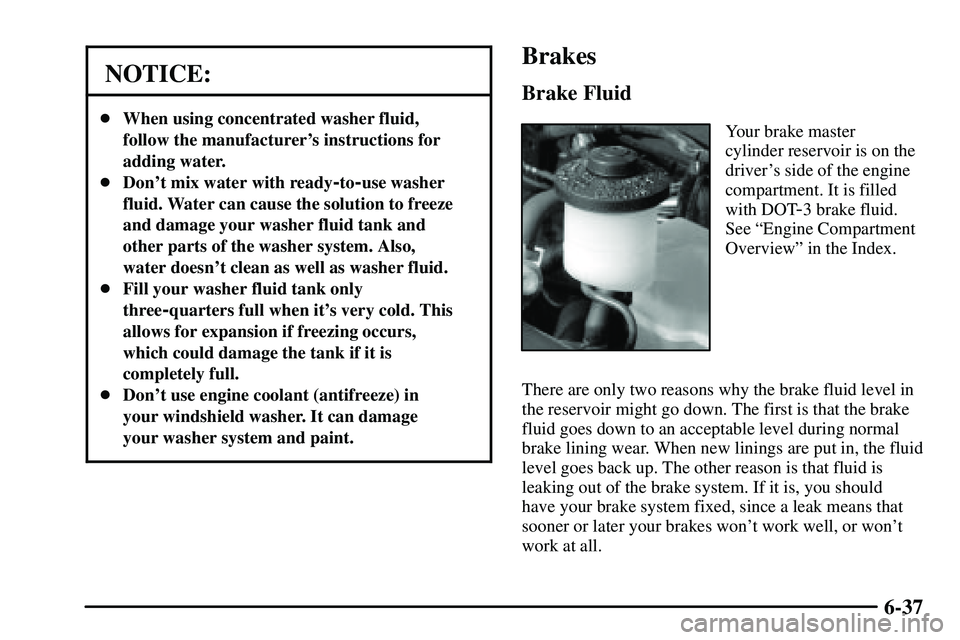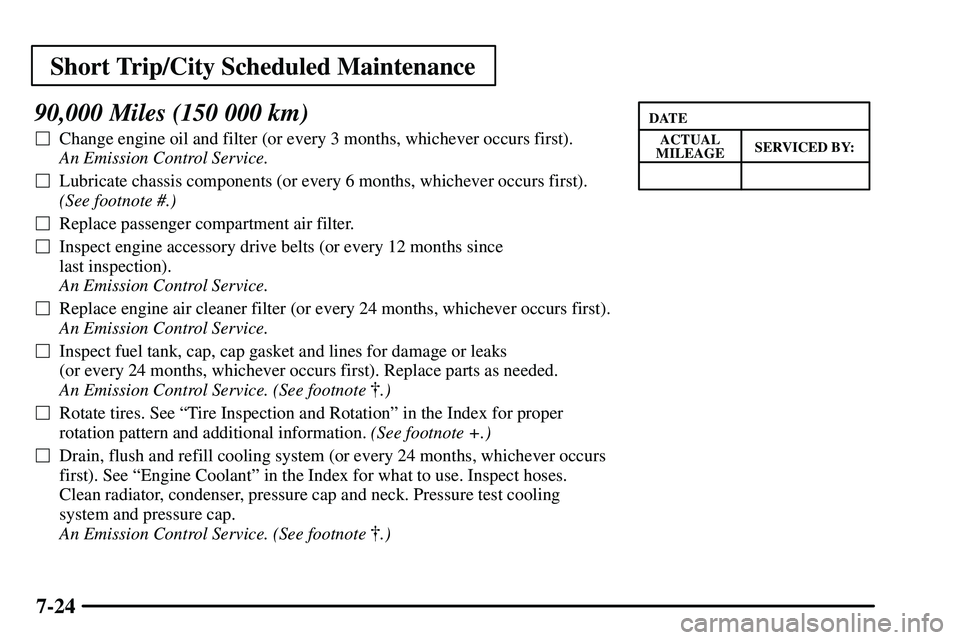Page 276 of 381

6-31 Carrier Assembly-Differential
(Rear Drive Module)
When to Check and Change Lubricant
Refer to the Maintenance Schedule to determine how
often to check the lubricant and when to change it. See
ªScheduled Maintenance Servicesº in the Index.
How to Check Lubricant
To get an accurate reading, the vehicle should be on
a level surface.
If the level is below the bottom of the filler plug hole,
you'll need to add some lubricant. Add enough lubricant
to raise the level to the bottom of the filler plug hole. A
fluid loss could indicate a problem; check and have it
repaired, if needed.
What to Use
Refer to the Maintenance Schedule to determine what
kind of lubricant to use. See ªRecommended Fluids
and Lubricantsº in the Index.
Engine Coolant
The following explains your cooling system and how
to add coolant when it is low. If you have a problem
with engine overheating, see ªEngine Overheatingº
in the Index.
A 50/50 mixture of clean, drinkable water and the
proper coolant will:
�Give freezing protection down to
-34�F (-37�C).
�Give boiling protection up to 265�F (129�C).
�Protect against rust and corrosion.
�Help keep the proper engine temperature.
�Let the warning lights and gages work as
they should.
Page 277 of 381

6-32 What to Use
Use a mixture of one-half clean, drinkable water and
one
-half coolant that meets GM Specification 1825-M,
which won't damage aluminum parts. You can also use a
recycled coolant conforming to GM Specification 1825
-M
with a complete coolant flush and refill. If you use this
coolant mixture, you don't need to add anything else.
CAUTION:
Adding only plain water to your cooling system
can be dangerous. Plain water, or some other
liquid such as alcohol, can boil before the proper
coolant mixture will. Your vehicle's coolant
warning system is set for the proper coolant
mixture. With plain water or the wrong mixture,
your engine could get too hot but you wouldn't
get the overheat warning. Your engine could
catch fire and you or others could be burned. Use
a 50/50 mixture of clean, drinkable water and the
proper coolant.
NOTICE:
If you use an improper coolant mixture, your
engine could overheat and be badly damaged.
The repair cost wouldn't be covered by your
warranty. Too much water in the mixture can
freeze and crack the engine, radiator, heater core
and other parts.
If you have to add coolant more than four times a year,
have your dealer check your cooling system.
NOTICE:
If you use the proper coolant, you don't have to
add extra inhibitors or additives which claim to
improve the system. These can be harmful.
Page 278 of 381

6-33 Checking Coolant
The vehicle must be on a
level surface. When your
engine is cold, the coolant
level should be at LOW, or
a little higher. When your
engine is warm, the level
should be up to FULL, or
a little higher.
Adding Coolant
If you need more coolant, add the proper coolant
mixture at the coolant recovery tank, but be careful
not to spill it.CAUTION:
Turning the radiator pressure cap when the
engine and radiator are hot can allow steam and
scalding liquids to blow out and burn you badly.
With the coolant recovery tank, you will almost
never have to add coolant at the radiator.
Never turn the radiator pressure cap
-- even a
little
-- when the engine and radiator are hot.
CAUTION:
You can be burned if you spill coolant on hot
engine parts. Coolant contains ethylene glycol,
and it will burn if the engine parts are hot
enough. Don't spill coolant on a hot engine.
Occasionally check the coolant level in the radiator. For
information on how to add coolant to the radiator, see
ªCooling Systemº in the Index.
Page 279 of 381
6-34
Radiator Pressure Cap
NOTICE:
Your radiator cap is a 15 psi (105 kPa)
pressure
-type cap and must be tightly installed to
prevent coolant loss and possible engine damage
from overheating. Be sure the arrows on the cap
line up with the overflow tube on the radiator
filler neck.
See ªEngine Compartment Overviewº in the Index for
more information on location.
Power Steering Fluid
When to Check Power Steering Fluid
It is not necessary to regularly check power steering
fluid unless you suspect there is a leak in the system or
you hear an unusual noise. A fluid loss in this system
could indicate a problem. Have the system inspected and
repaired. See ªEngine Compartment Overviewº in the
Index for reservoir location.
The power steering fluid
reservoir is located in the
engine compartment on
the passenger's side of
the vehicle.
Page 282 of 381

6-37
NOTICE:
�When using concentrated washer fluid,
follow the manufacturer's instructions for
adding water.
�Don't mix water with ready
-to-use washer
fluid. Water can cause the solution to freeze
and damage your washer fluid tank and
other parts of the washer system. Also,
water doesn't clean as well as washer fluid.
�Fill your washer fluid tank only
three
-quarters full when it's very cold. This
allows for expansion if freezing occurs,
which could damage the tank if it is
completely full.
�Don't use engine coolant (antifreeze) in
your windshield washer. It can damage
your washer system and paint.
Brakes
Brake Fluid
Your brake master
cylinder reservoir is on the
driver's side of the engine
compartment. It is filled
with DOT
-3 brake fluid.
See ªEngine Compartment
Overviewº in the Index.
There are only two reasons why the brake fluid level in
the reservoir might go down. The first is that the brake
fluid goes down to an acceptable level during normal
brake lining wear. When new linings are put in, the fluid
level goes back up. The other reason is that fluid is
leaking out of the brake system. If it is, you should
have your brake system fixed, since a leak means that
sooner or later your brakes won't work well, or won't
work at all.
Page 336 of 381

Short Trip/City Scheduled Maintenance
7-13
30,000 Miles (50 000 km)
�Change engine oil and filter (or every 3 months, whichever occurs first).
An Emission Control Service.
�Lubricate chassis components (or every 6 months, whichever occurs first).
(See footnote #.)
�Replace passenger compartment air filter.
�Replace engine air cleaner filter (or every 24 months, whichever occurs first).
An Emission Control Service.
�Inspect fuel tank, cap, cap gasket and lines for damage or leaks
(or every 24 months, whichever occurs first). Replace parts as needed.
An Emission Control Service. (See footnote �.)
�Rotate tires. See ªTire Inspection and Rotationº in the Index for proper
rotation pattern and additional information. (See footnote +.)
�Drain, flush and refill cooling system (or every 24 months, whichever occurs
first). See ªEngine Coolantº in the Index for what to use. Inspect hoses.
Clean radiator, condenser, pressure cap and neck. Pressure test cooling
system and pressure cap.
An Emission Control Service. (See footnote �.)
�Change manual transaxle fluid every 30,000 miles (50 000 km) only if your
vehicle is used to tow a trailer.
�Check automatic transaxle fluid.
�Change transfer case fluid when doing frequent trailer towing.
�Change rear differential fluid when doing frequent trailer towing.ACTUAL
SERVICED BY:MILEAGE
DATE
Page 342 of 381

Short Trip/City Scheduled Maintenance
7-19
�Drain, flush and refill cooling system (or every 24 months, whichever occurs
first). See ªEngine Coolantº in the Index for what to use. Inspect hoses.
Clean radiator, condenser, pressure cap and neck. Pressure test cooling
system and pressure cap.
An Emission Control Service. (See footnote �.)
�Change manual transaxle fluid every 30,000 miles (50 000 km) only if your
vehicle is used to tow a trailer.
�Change automatic transaxle fluid every 60,000 miles (100 000 km) if the
vehicle is mainly driven under one or more of these conditions:
± In heavy city traffic where the outside temperature regularly
reaches 90�F (32�C) or higher.
± In hilly or mountainous terrain.
± When doing frequent trailer towing.
± Uses such as found in taxi, police or delivery service.
If you do not use your vehicle under any of these conditions, check the fluid.
See ªRecommended Fluids and Lubricantsº in the Index for the proper
fluid to use.
�Change transfer case fluid when doing frequent trailer towing.
�Change rear differential fluid when doing frequent trailer towing.
Page 347 of 381

Short Trip/City Scheduled Maintenance
7-24
90,000 Miles (150 000 km)
�Change engine oil and filter (or every 3 months, whichever occurs first).
An Emission Control Service.
�Lubricate chassis components (or every 6 months, whichever occurs first).
(See footnote #.)
�Replace passenger compartment air filter.
�Inspect engine accessory drive belts (or every 12 months since
last inspection).
An Emission Control Service.
�Replace engine air cleaner filter (or every 24 months, whichever occurs first).
An Emission Control Service.
�Inspect fuel tank, cap, cap gasket and lines for damage or leaks
(or every 24 months, whichever occurs first). Replace parts as needed.
An Emission Control Service. (See footnote �.)
�Rotate tires. See ªTire Inspection and Rotationº in the Index for proper
rotation pattern and additional information. (See footnote +.)
�Drain, flush and refill cooling system (or every 24 months, whichever occurs
first). See ªEngine Coolantº in the Index for what to use. Inspect hoses.
Clean radiator, condenser, pressure cap and neck. Pressure test cooling
system and pressure cap.
An Emission Control Service. (See footnote �.)ACTUAL
SERVICED BY:MILEAGE
DATE